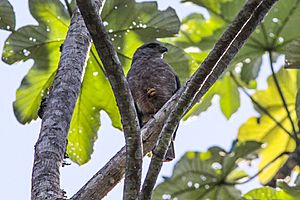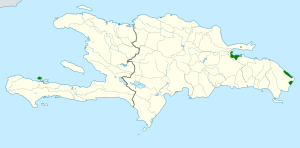Ridgway's hawk facts for kids
Quick facts for kids Ridgway's hawk |
|
|---|---|
 |
|
| Conservation status | |
| Scientific classification | |
| Genus: |
Buteo
|
| Species: |
ridgwayi
|
 |
|
| Range in green | |
| Synonyms | |
|
Rupornis ridgwayi |
|
The Ridgway's hawk (Buteo ridgwayi) is a special bird of prey. It lives only on the island of Hispaniola in the Caribbean. This island is home to both Haiti and the Dominican Republic. This hawk is currently listed as Critically Endangered. This means it is at a very high risk of disappearing forever.
Its numbers dropped because its home was destroyed. Also, some people harmed them in the Dominican Republic. But thanks to hard work by conservation groups, their population is now growing! This hawk was named after a bird expert named Robert Ridgway.
Contents
What Does the Ridgway's Hawk Look Like?
The Ridgway's hawk is a medium-sized hawk. It is about 36 to 41 centimeters (14 to 16 inches) long. Its upper body is a brownish-grey color. Its belly has grey bars with a reddish-brown tint. Its upper legs are reddish-brown.
The hawk's tail has black and white stripes. Male hawks are usually greyer than females. Both males and females have yellow legs. The base of their beak is also yellow.
What Do Ridgway's Hawks Eat and How Do They Reproduce?
Ridgway's hawks are hunters. They eat many different animals. Their diet includes small animals like rodents and bats. They also eat insects like centipedes.
These hawks also hunt other birds, anoles, skinks, frogs, and snakes. They build their nests high up in tall trees. They often choose trees like the Roystonea borinquena palm.
They start building nests in December and continue until June. Eggs are laid from January to June. A female hawk usually lays 1 to 3 eggs. Most hawk pairs raise 1 or 2 young birds. Sometimes, they might raise 3.
Where Do Ridgway's Hawks Live?
The Ridgway's hawk used to live all over Hispaniola. It also lived on nearby small islands. These islands included Gonâve Island, Île-à-Vache, Tortuga, Beata Island, and Alto Velo Island.
However, their homes have been greatly reduced. This is due to a lot of forests being cut down. Because of this, they are now gone from most of Haiti. They are also gone from many parts of the Dominican Republic.
For a while, people thought they were completely gone from Haiti. But recently, some hawks were found living on the Les Cayemites islands. In the Dominican Republic, most hawks live in Los Haitises National Park. A small group also lives in the Samaná Peninsula.
Helping the Ridgway's Hawk Survive
The Ridgway's hawk is in great danger. Its forest home is being cleared away. Also, some local farmers have harmed them. They thought the hawks were eating their farm animals, like chickens.
But experts say that farm animals are not a big part of the hawk's diet. Hawks eat many different things. Reptiles, like lizards and snakes, make up most of their food.
Other dangers include getting shocked by power lines. Also, tiny flies called Philornis pici can harm baby hawks in their nests.
Good news! Efforts to help them are working. Some hawks have been released in the Ecological Center of the Puntacana Resort and Club. This place is in La Altagracia Province. These releases have been very successful.
Twenty-five hawks were also set free in Aniana Vargas National Park. This park is in Sánchez Ramírez Province. More releases are planned for the future. Some people have suggested a "Ridgway's Hawk Day." This would be a national holiday in the Dominican Republic. It would help more people learn about and protect this special bird.
See also
 In Spanish: Busardo de La Española para niños
In Spanish: Busardo de La Española para niños


